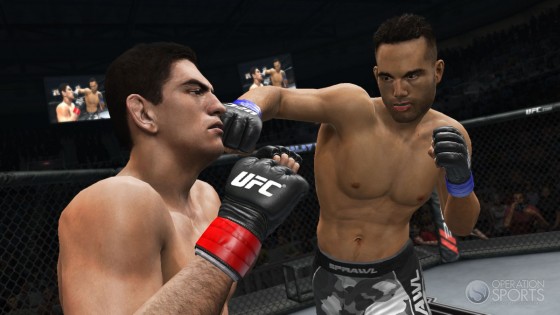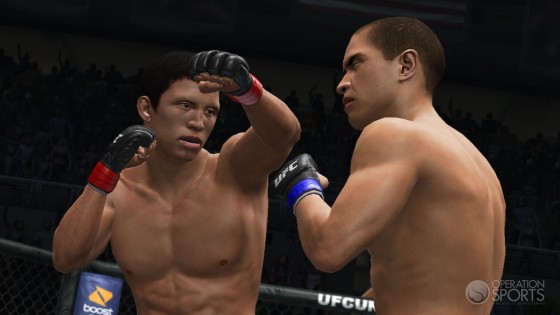

Surviving in the virtual Octagon remains challenging in UFC 3, even with the new “amateur” controls. While the new scheme may help with some of the delicate transitions that take place in a fight, there are many other small concepts to wrap your head around in order to have success in the offline and online arenas.

First law of UFC Undisputed 3...know your limits. Your fighter isn't perfect.
Know Your Fighter's Limits
It's tempting to utilize the complete tool set that UFC Undisputed 3 puts in front of you, but what you have to remember — and this is extremely true for online play — is that not all fighters are created equal. More often than not, you're going to have a fighter who has some aspect of his game that is not on par with peers in the division.
For instance, take Pat Barry, a gifted heavyweight striker. You really shouldn't be attempting double-leg takedowns with him unless you're absolutely desperate. True, he can attempt them, but his statistics in that category are quite low, and even if he gets an opponent down, he's not going to have the top control or submission skills to do anything with it. Stick to the striking game with a guy like Barry.
At the same time, you have to know that other fighters have these limits as well, whether human or CPU. If an opposing player is trying all sorts of wild headkicks and leaving themselves open to a takedown, which might be your speciality, then go for it. This is especially true for BJJ and submission fighters, who should really be utilizing the new-found jab of UFC Undisputed 3 to set up takedowns and clinch work to get the fight to the ground.
Respect the Rules
It's very important to know what the the settings and rules are for the match you are about participate in. There are obvious differences between UFC and PRIDE rules — round times, scoring system, types of strikes allowed — so you would be wise to keep these in mind when planning out the aggression, pace and set up of your attacks. Your stamina is key to survival in the game, so specific rule sets might make you think twice about going for it all right away or waiting until the end.
It's also very important to be aware of the advantages and disadvantages of the simulation, default and competition settings. If simulation settings are activated, you're going to have to pace your attacks accordingly and not flail wildly, because you'll have much less stamina than normal. Just the same, competition settings will remove doctor stoppages and adverse effects from cuts, so you'll be able to be more aggressive in those sorts of situations, whereas on default you would be wise not to. Finally, having equalized stats turned on means both fighters will be at parity in their stats, and only their unique strikes and submissions will set them apart.

The octagon is yours to control. You just have to do it.
Control the Octagon
At all costs, don't let yourself get bullied in a fight. Putting yourself in the middle of the Octagon and using range-finder punches and kicks is a good way of keeping an aggressor at bay, as are feint punches and kicks. You always want to be moving, though, and not get caught up in any exchanges that last more than five seconds.
If you establish your presence in the middle of the Octagon, you'll be able to set up some collar and Thai clinches that are lethal when you push an opposing fighter up against the cage. Generally speaking, the less you are backing up, the better off you'll be. Your options are limited when pushed up against the cage, especially since UFC games have never had the greatest lateral movement, and your opponent will be able to see your desperate strikes and takedowns from a mile away.
Learn the Transitions
Take the time get familiar with the transition system in UFC Undisputed 3. If you need to, give the amateur control setup a go, as it can make the transitions easier and quicker to pull off. The catch is that you lose out on some of the subtlety on the ground, where the “pro” control scheme allows for stalling in the transition to throw off the other fighter's timing.
Against a skilled opponent, either in pure ability or statistically speaking, you want to be focusing on the minor transitions the most. If you get put on your back, you just want to survive. Hold back on the right stick to block transitions until you get your bearings. Mix up your timing and then execute a minor transition to improve your position. Above all else, you want to control posture and pummel to better clinch and ground positions. Don't go for the major transitions until you've sufficiently mastered the timing of an opposing fighter.

You have to avoid your opponents punches. If that wasn't obvious already.
Use Sways and Feints
To survive on your feet, and this year more so on the ground, you would be well served to work some feinted strikes and sways into your arsenal. Head sways are great when engaging a fighter in the pocket, as you can bob and weave back and forth and side to side until you are ready to land a good counter. Sways are a nice way to set up some great headkicks, too. Sways on the ground are valuable when an opponent has postured up and is dropping bombs. Flick the left stick, while blocking, to the sides in order to avoid some critical damage. With feints, you just generally want mix them in here and there so that the other guy never quite has your timing or strike selection down. You can make him respect kicks that you never actually throw, or you can use them to set up a big superman punch.
Mix Up Your Attacks
Definitely do not get predictable with your strikes, takedowns and transitions. What works well against one fighter is likely not going to work against many others. Consider using the aforementioned feints and sways to keep your opponents guessing as to when you'll deliver a big strike. Even better, consider faking a big punch and then leaning in for a takedown.
This unpredictable timing is doubly important on the ground, where transitions rule the day. Consider using some baby punches when on your back in order to inflict some miniscule free damage and then attempt a transition to hip escape or improve position. If you just instantly start spamming transitions in a panic, the fighter on top will be waiting for that every time.

Don't just go throwing punches wildly. There's a bit of strategy involved.
Don't Get Dragged into a Brawl
It certainly can be fun to just throw down sometimes, but if you want to progress in the offline modes or have success online, don't just start trading wildly and hoping to land a bunch of bombs. Sure, you may be able to pull this off here and there, but you could also get counter-struck and knocked out quickly. In addition, you may also get gassed, especially if the game is on simulation settings.
What you want to be doing is taking advantage of someone who is trying to turn it into a brawl. Watch for their telegraphed flurries and go for a takedown or body clinch if they leave it out there. If you do get caught in the pocket when they are throwing bombs, use some head sways to land a devastating counter-punch, as it is big damage on all counter-strikes in this game.
Final Thoughts
If you stay patient in the Octagon — or PRIDE ring — you'll be able to see many of the patterns that CPU and human fighters use to bully you or put you off balance. When you're aware of what your fighter is capable of and how you should be handling certain situations, UFC Undisputed 3 really rewards that level of studiousness.




 Madden NFL 12: Winning on Draft Day
Madden NFL 12: Winning on Draft Day NCAA 10: Blocking Logic Flaws Make for Big Defense
NCAA 10: Blocking Logic Flaws Make for Big Defense OS Tip of the Day: Never Waste Time in SSX
OS Tip of the Day: Never Waste Time in SSX OS Tip of the Day: The First Tricks Matter in SSX
OS Tip of the Day: The First Tricks Matter in SSX Madden NFL 12: Best Position Switches
Madden NFL 12: Best Position Switches